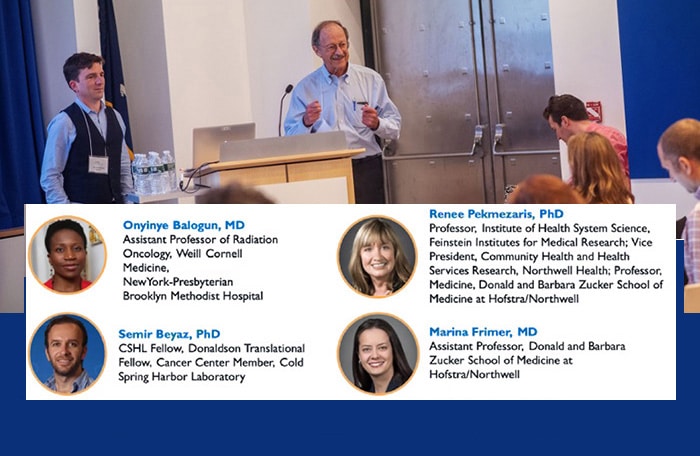“We offer this preliminary report of our experience to date with P-1000 in the hope that investigators in other regions of the USA and other countries will be encouraged to develop similar programs, to make use of the WGS [whole genome sequencing] data that we will ultimately provide, to use such projects as platforms for training students and fellows in the conduct of research on ethnicity, medical genomics, and health disparities, and to confer with us about more equitable ways to pursue cancer science through engagement with populations of patients who more broadly represent the genetic diversity of our species.”
This vision statement concludes the “Science & Society” essay New York’s Polyethnic-1000: a regional initiative to understand how diverse ancestries influence the risk, progression, and treatment of cancers, written by Harold Varmus, MD, Senior Associate Core Member, New York Genome Center (NYGC), and Lewis Thomas University Professor of Medicine, Weill Cornell Medicine, and Nicolas Robine, PhD, Director, Computational Biology, Cancer, and Functional Genomics, NYGC, and published in Trends in Cancer last month.
Polyethnic-1000, or P-1000, is overseen by the NYGC’s Genome Center Cancer Group, which is led by Dr. Varmus along with Charles Sawyers, MD, Chair, Human Oncology and Pathogenesis Program, Marie-Josée and Henry R. Kravis Chair, Memorial Sloan Kettering Cancer Center, and Affiliate Member, NYGC, and composed of clinicians and cancer researchers from NYGC’s member institutions, including 10 NCI-Designated Cancer Centers. Dr. Robine is among the members of the P-1000 steering committee.

In the Trends in Cancer essay, Drs. Varmus and Robine tee up the driving goal of the initiative: to “repair deficiencies in knowledge about the influence of inherited genetic diversity on disease,” given “most of the patients included in these [current genomic research] studies are of Western European descent, reducing opportunities to study cancer in the context of the broad expanse of human diversity.” Their essay then goes on to detail the essential first-phase steps of P-1000, which included:
- Formation of a multi-institutional network of collaborators throughout New York City, including scientists, pathologists, local Institutional Review Boards, and administrators
- Establishment of a scientific leadership steering committee and review board
- Creation of a centralized, secure system for data management, sharing, analysis, and quality controls
- Development of a data sharing platform, including visualization tools

With this key infrastructure established, P-1000 is now in its second phase, with seven new multi-institutional cancer projects recipients in 2020 of grant funding and now underway. These P-1000 project teams are investigating a variety of cancers, including pancreatic, colorectal and endometrial cancer in African Americans; lung cancer in Asian American patients; breast and prostate cancer in, patients of African ancestry; multiple myeloma in African Americans; and the role of ethnicity in bladder cancer. “Leaving people out is an equity issue and a knowledge issue,” noted Dr. Varmus in the feature story in The New York Times about the P-1000 projects.
And as these project progress, year-end 2021 brought some breaking, related news: The team involved in the P-1000 project “Mechanisms of Endometrial Cancer Disparities in African Americans” was among the inaugural recipients of an Ancestry Networks award from the Chan Zuckerberg Initiative. This new funding program supports expanding the ancestral diversity of the samples in the Human Cell Atlas, the international effort to map all cells in the human body as a foundational resource for understanding health and disease.
With this Ancestry Networks Award funding, this P-1000 project team (pictured above; click image to enlarge) is now undertaking a related project to develop an ancestrally representative “multi-omics” cellular atlas of the human endometrium — the tissue lining the uterus. The scientists will do this by conducting genomic analyses of samples from an already established tissue biobank that includes self-reported diverse ancestries and comprehensive clinical annotation, including on pregnancy history, menstruation, weight, and socioeconomic factors. An important aspect of the project is community outreach. The project team plans to conduct education and outreach activities designed to raise awareness of the benefits and value of participating in biomedical research and address the questions and concerns of the communities the study serves. Taken together, these activities will help researchers gain a more complete picture of the biological factors and molecular mechanisms involved in endometrial cancers, endometriosis, and fertility.
“Genomic databases are becoming a key element of the drug discovery process. Making sure that these databases are representative of the global population is critical to make sure that every patient can benefit from these novel therapies and treatments,” noted Dr. Robine as part of the award announcement.

Ancestry Networks Award co-grantee Onyinye Balogun, MD and Melissa B. Davis, PhD, (l-r in photo at left) both esteemed health disparities researchers at Weill Cornell Medicine, serve as Ethnicity and Cancer Scholars for P-1000.
Dr. Davis is author of another recent “Science & Society” essay, entitled Understanding how genetic ancestry may influence cancer development, published by Trends in Cancer this month.
For the latest news on the Polyethnic-1000 initiative, visit the P-1000 site on nygenome.org and follow @polyethnic1000 and @nygenome.

